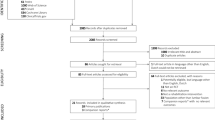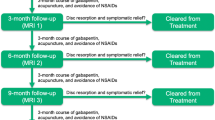Abstract
Purpose
Few studies examine the clinical outcomes in patients undergoing minimally invasive transforaminal lumbar interbody fusion (MIS-TLIF) versus lateral lumbar interbody fusion (LLIF) for adjacent segment disease (ASD). We aim to compare the postoperative clinical trajectory through patient-reported outcome measures (PROMs) and minimum clinically important difference (MCID) in patients undergoing MIS-TLIF versus LLIF for ASD.
Methods
Patients were stratified into two cohorts based on surgical technique for ASD: MIS-TLIF versus LLIF. PROMs of 12-Item Short Form Physical Component Score (SF-12 PCS), visual analog scale (VAS) back, VAS leg, and Oswestry Disability Index (ODI) were collected at preoperative and postoperative 6-week/12-week/6-month/1-year time points. MCID attainment was calculated through comparison to established thresholds. Cohorts were compared through nonparametric inferential statistics.
Results
Fifty-four patients were identified, with 22 patients undergoing MIS-TLIF after propensity score matching. Patients undergoing MIS-TLIF for ASD demonstrated significant postoperative improvement up to 1-year VAS back, up to 1-year VAS leg, and 6-month through 1-year ODI (p ≤ 0.035, all). Patients undergoing LLIF demonstrated significant postoperative improvement in 6-month SF-12 PCS, 6-month through 1-year VAS back, 12-week through 6-month VAS leg, and 6-month to 1-year ODI (p ≤ 0.035, all). No significant differences were calculated between surgical techniques for PROMs or MCID achievement rates.
Conclusion
Patients undergoing either MIS-TLIF or LLIF for adjacent segment disease demonstrated significant postoperative improvement in pain and disability outcomes. Additionally, patients undergoing LLIF reported significant improvement in physical function. Both MIS-TLIF and LLIF are effective for the treatment of adjacent segment disease.
Similar content being viewed by others
Abbreviations
- ASA:
-
American Society of Anesthesiologists
- ASD:
-
Adjacent segment disease
- BMI:
-
Body mass index
- CCI:
-
Charlson comorbidity index
- EBL:
-
Estimated blood loss
- FEA:
-
Finite element analysis
- HNP:
-
Herniated nucleus pulposus
- JOA:
-
Japanese Orthopedic Association
- LLIF:
-
Lateral lumbar interbody fusion
- LL:
-
Lumbar lordosis
- LOS:
-
Length of stay
- MCID:
-
Minimum clinically important difference
- MIS-TLIF:
-
Minimally invasive transforaminal lumbar interbody fusion
- ODI:
-
Oswestry disability index
- OLIF:
-
Oblique lateral interbody fusion
- OME:
-
Oral morphine equivalents
- ORA:
-
Office of Regulatory Affairs
- PLIF:
-
Posterior lumbar interbody fusion
- POD:
-
Postoperative day
- PROMs:
-
Patient-reported outcome measures
- SF-12 PCS:
-
12-Item Short Form Physical Component Score
- SL:
-
Segmental lordosis
- VAS:
-
Visual analog scale
References
Chang SY, Chae IS, Mok S, Park SC, Chang BS, Kim H (2021) Can indirect decompression reduce adjacent segment degeneration and the associated reoperation rate after lumbar interbody fusion? A systemic review and meta-analysis. World Neurosurg 153:e435–e445
Chen DA, Vaishnav AS, Louie PK et al (2020) Patient reported outcomes in patients who stop following up: Are they doing better or worse than the patients that come back? Spine (Phila Pa 1976) 45(20):1435–1442
Davis TT, Bae HW, Mok JM, Rasouli A, Delamarter RB (2011) Lumbar plexus anatomy within the psoas muscle: implications for the transpsoas lateral approach to the L4-L5 disc. J Bone Joint Surg Am 93(16):1482–1487
Ebrahimkhani M, Arjmand N, Shirazi-Adl A (2021) Biomechanical effects of lumbar fusion surgery on adjacent segments using musculoskeletal models of the intact, degenerated and fused spine. Sci Rep 11(1):17892
Hilibrand AS, Robbins M (2004) Adjacent segment degeneration and adjacent segment disease: the consequences of spinal fusion? Spine J 4(6 Suppl):190S–194S
Hockley A, Ge D, Vasquez-Montes D et al (2019) Minimally invasive versus open transforaminal lumbar interbody fusion surgery: an analysis of opioids, nonopioid analgesics, and perioperative characteristics. Global Spine J 9(6):624–629
Jacob KC, Patel MR, Ribot MA et al (2022) Single-level TLIF versus LLIF at L4-5: a comparison of patient-reported outcomes and recovery ratios. J Am Acad Orthop Surg 30(4):e495–e505
Jiang S, Li W (2019) Biomechanical study of proximal adjacent segment degeneration after posterior lumbar interbody fusion and fixation: a finite element analysis. J Orthop Surg Res 14(1):135
Li GQ, Tong T, Wang LF (2022) Comparative analysis of the effects of OLIF and TLIF on adjacent segments after treatment of L4 degenerative lumbar spondylolisthesis. J Orthop Surg Res 17(1):203
Liang Z, Cui J, Zhang J et al (2020) Biomechanical evaluation of strategies for adjacent segment disease after lateral lumbar interbody fusion: is the extension of pedicle screws necessary? BMC Musculoskelet Disord 21(1):117
Louie PK, Haws BE, Khan JM et al (2019) Comparison of stand-alone lateral lumbar interbody fusion versus open laminectomy and posterolateral instrumented fusion in the treatment of adjacent segment disease following previous lumbar fusion surgery. Spine (Phila Pa 1976) 44(24):E1461–E1469
Mobbs RJ, Phan K, Malham G, Seex K, Rao PJ (2015) Lumbar interbody fusion: techniques, indications and comparison of interbody fusion options including PLIF, TLIF, MI-TLIF, OLIF/ATP LLIF and ALIF. J Spine Surg 1(1):2–18
Moro T, Kikuchi SI, Konno SI, Yaginuma H (2003) An anatomic study of the lumbar plexus with respect to retroperitoneal endoscopic surgery. Spine (Phila Pa 1976) 28(5):423–428 discussion 427-8
Okuda S, Yamashita T, Matsumoto T et al (2018) Adjacent segment disease after posterior lumbar interbody fusion: a case series of 1000 patients. Global Spine J. 8(7):722–727
Parker SL, Adogwa O, Paul AR et al (2011) Utility of minimum clinically important difference in assessing pain, disability, and health state after transforaminal lumbar interbody fusion for degenerative lumbar spondylolisthesis. J Neurosurg Spine 14(5):598–604
Parker SL, Mendenhall SK, Shau D et al (2012) Determination of minimum clinically important difference in pain, disability, and quality of life after extension of fusion for adjacent-segment disease. J Neurosurg Spine 16(1):61–67
Qin R, Wu T, Liu H, Zhou B, Zhou P, Zhang X (2020) Minimally invasive versus traditional open transforaminal lumbar interbody fusion for the treatment of low-grade degenerative spondylolisthesis: a retrospective study. Sci Rep 10(1):21851
Regev GJ, Chen L, Dhawan M, Lee YP, Garfin SR, Kim CW (2009) Morphometric analysis of the ventral nerve roots and retroperitoneal vessels with respect to the minimally invasive lateral approach in normal and deformed spines. Spine (Phila Pa 1976) 34(12):1330–1335
Trivedi NN, Wilson SM, Puchi LA, Lebl DR (2018) Evidence-based analysis of adjacent segment degeneration and disease after LIF: a narrative review. Global Spine J 8(1):95–102
Vora D, Kinnard M, Falk D et al (2018) A comparison of narcotic usage and length of post-operative hospital stay in open versus minimally invasive lumbar interbody fusion with percutaneous pedicle screws. J Spine Surg 4(3):516–521
Yang Z, Chang J, Sun L, Chen CM, Feng H (2020) Comparing oblique lumbar interbody fusion with lateral screw fixation and transforaminal full-endoscopic lumbar discectomy (OLIF-TELD) and posterior lumbar interbody fusion (PLIF) for the treatment of adjacent segment disease. Biomed Res Int 2020:4610128
Yasmeh S, Bernatz J, Garrard E, Bice M, Williams SK (2021) Clinical and radiographic outcomes of lateral interbody fusion for adjacent segment degeneration. Int J Spine Surg 15(1):74–81
Author information
Authors and Affiliations
Contributions
James W. Nie, BS: Conceptualization, methodology, visualization, formal analysis, software, investigation, writing—original draft, and writing—review and editing. Timothy J. Hartman, MD: Conceptualization, methodology, visualization, formal analysis, software, investigation, writing—original draft, and writing—review and editing. Eileen Zheng, BS: Project administration, data curation, investigation, and writing—review and editing. Keith R. MacGregor, BS: Project administration, data curation, investigation, and writing—review and editing. Omolabake O. Oyetayo, BS: Project administration, data curation, investigation, and writing—review and editing. Dustin H. Massel, MD: Conceptualization, methodology, supervision, resources, investigation, and writing—review and editing. Arash J. Sayari, MD: Conceptualization, methodology, supervision, resources, investigation, and writing—review and editing. Kern Singh, MD: Conceptualization, methodology, supervision, resources, investigation, and writing—review and editing.
Corresponding author
Additional information
Publisher’s note
Springer Nature remains neutral with regard to jurisdictional claims in published maps and institutional affiliations.
Rights and permissions
Springer Nature or its licensor (e.g. a society or other partner) holds exclusive rights to this article under a publishing agreement with the author(s) or other rightsholder(s); author self-archiving of the accepted manuscript version of this article is solely governed by the terms of such publishing agreement and applicable law.
About this article
Cite this article
Nie, J.W., Hartman, T.J., Zheng, E. et al. Postoperative clinical outcomes in patients undergoing MIS-TLIF versus LLIF for adjacent segment disease. Acta Neurochir 165, 1907–1914 (2023). https://doi.org/10.1007/s00701-023-05629-z
Received:
Accepted:
Published:
Issue Date:
DOI: https://doi.org/10.1007/s00701-023-05629-z




